Although many associate the Chinese Water Dragon with only China, Water Dragons are actually a breed of lizard originating from many different parts of Asia including Thailand, Cambodia, Vietnam, and Laos.
They are a bright green lizard with a long pointy tail. Like the Uromastyx, this long tail is used as a weapon against predators and for balance when running, climbing, or swimming.
Most captive Chinese Water Dragons have been wild-caught, which means they will not be as docile as most pet lizards.
However, they are inexpensive (around $50) and can still make excellent pets for experienced hobbyists.
If you think you can tame this Dragon, and want to know more about how to care for them, then check out our care guide below…
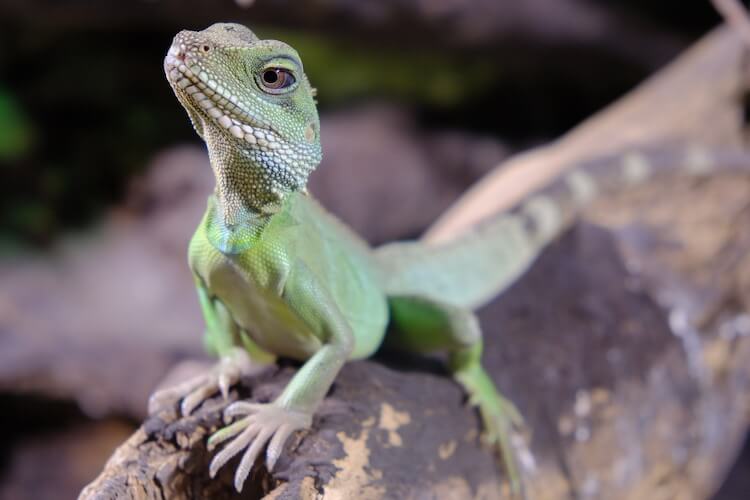
Chinese Water Dragon Overview
Originating from the warmer forests of southern Asia, this lizard spends most of its time along bodies of water.
Chinese Water Dragons use water as a shelter when threatened, retreating and staying submerged until the threat has passed. Some have been known to hold their breath underwater for up to 90 minutes.
Compared to other pet lizard species, Water Dragons can be difficult to care for in captivity.
This is due to their large-size, unpredictable temperament, and tendency to develop veterinary issues such as bacterial infections.
Most water dragons are wild-caught. They are listed as having a “vulnerable” conservation status, and their population is declining in the wild. Because they are still wild, they can sometimes be flighty and aggressive.
What We Like About Chinese Water Dragons
| Pros | Cons |
|---|---|
| Very active and energetic. | They require a large tank size. |
| Striking green color and brightly colored throat. | High temperature and humidity requirements. |
| Intelligent with many unique behaviors. | Tendency to develop health issues. |
Species Appearance
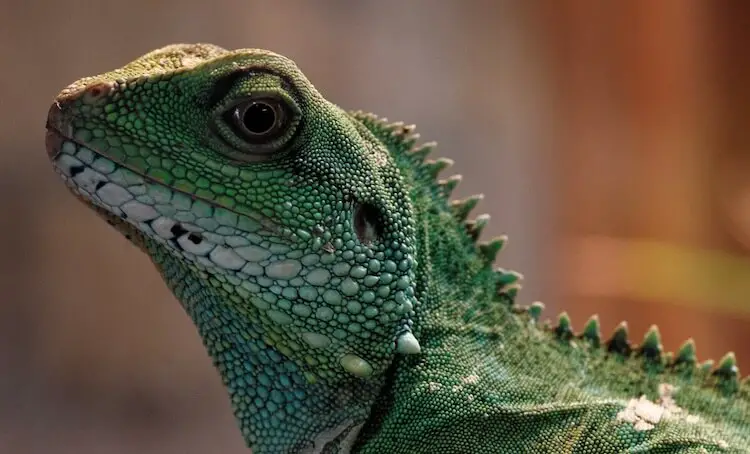
Female and male Water Dragons are sexually dimorphic, this makes them easy to tell apart:
- Males typically have larger spikes along their dorsal crest and much broader heads.
- Males also have much larger femoral pores along the inside of their thighs than females.
The most distinct difference between males and females is color.
Females typically have blue stripes along their backs and bright pink throats while males have black speckling and a bright orange throat.
Chinese Water Dragon Size
Males reach an adult size of approximately three feet in length and females are typically a little smaller. Females are fully grown at approximately two feet, weighing just over two pounds.
They will reach their adult size around one to two years of age but don’t become sexually mature until two to three years of age.
Hatchlings are about five to six inches in length.
Color Variations and Markings
Chinese water dragons are usually a variation of green (ranging from bright green to aqua) with a tan/brown-banded tail.
Their throats are a bright yellow, orange, or pink.
As far as markings go, they have white scales on their jaws and a jagged row of spines along the dorsal aspect of their neck and body.
There are no known true morphs.
Chinese Water Dragon Enclosure
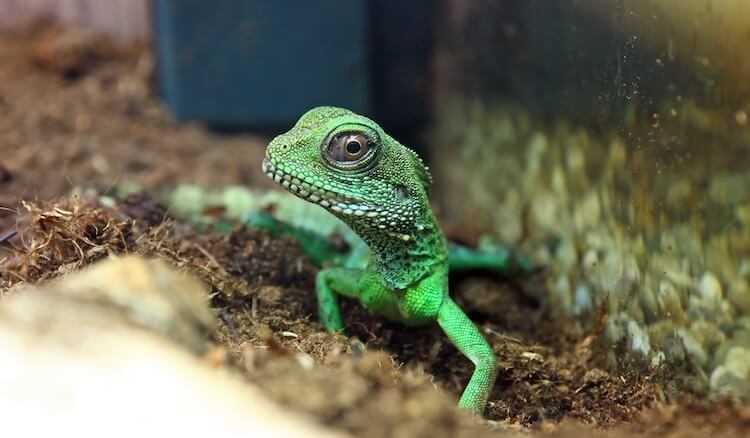
In the wild, these lizards spend most of their day basking on rocks and branches along bodies of water, and hunting for insects and other small organisms.
When kept in captivity, their habitat should provide opportunities for them to carry out these natural behaviors.
A designated basking spot is a must and plenty of branches should be included in the enclosure.
A pan of water is another necessary inclusion to their tank, as it allows them a safe space to flee when they feel threatened.
Live plants can also be added to help increase the humidity of the tank.
Enclosure Set Up
The Chinese Water Dragon has very specific requirements when it comes to their enclosure. Ideally, adults need a tank at least 75-gallons in size. This can equate with a tank that is 6 feet long and 4 feet tall.
Wooden vivariums are preferred over glass or mesh enclosures; due to their ability to retain heat and moisture well.
- Tank Type: wooden vivarium.
- Tank Size: 75-gallon.
- Lighting: UVB and UVA lighting for 10 to 12 hours each day.
- Substrate: Topsoil without any additives.
Owners must ensure that any vivarium they use is large enough for them to exhibit normal behaviors such as running, leaping, swimming, and basking.
The Chinese Water Dragon requires 10 to 12 hours of UVB and UVA lighting per day.
This lighting is essential to the Lizard’s ability to process calcium. Without it, they will develop various medical issues including metabolic bone disease.
Originating from the tropical forests of Southeast Asia, Chinese Water Dragons require a high temperature and humidity:
- Daytime enclosure temperature: 85 degrees (for 10 to 12 hours).
- Night-time enclosure temperature: 75 degrees.
A basking spot should be provided that is slightly warmer than the rest of their tank (~ at least 90 degrees). The humidity of the enclosure also must stay consistently high, remaining above 70% at all times.
Topsoil is an ideal choice of substrate. This allows for natural digging behaviors and absorbs humidity very well.
Additionally, with this species love of jumping from branches, it will provide a soft landing spot if they take an unexpected fall.
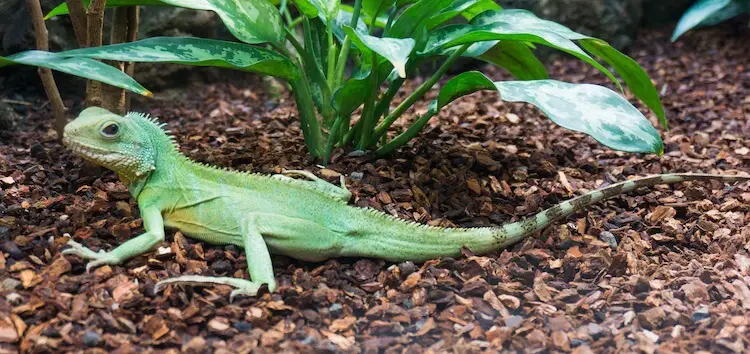
Cleaning & Misting
A pan of water should be included, and both the enclosure and the Chinese Water Dragon can be misted daily (if not twice daily). This will ensure that the humidity stays above 70%.
It is important to change the water in their enclosure daily as these reptiles are very prone to bacterial infections:
- Water should be changed daily.
- Feces should be removed from the tank daily.
- Soil or other substrates should be changed weekly.
Once a month, the tank should be thoroughly cleaned with soap and hot water. Everything should be removed when cleaning and substrate should be entirely replaced.
Chinese Water Dragon Care
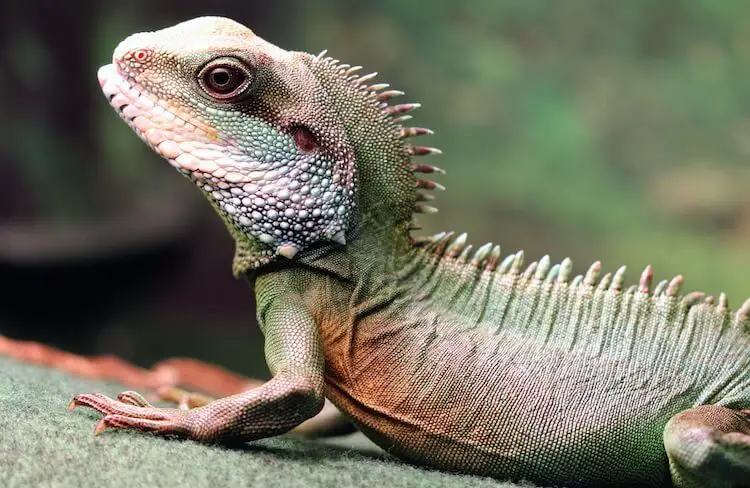
Chinese Water Dragon Diet
This species is omnivorous; their diet consists mostly of insects, small fish, small mammals, and other reptiles.
In the wild, Water Dragons enjoy hunting so providing live food is a must.
Additionally, they can be picky eaters so switching up their diet every is essential to ensuring they receive the nutrition they need.
It is recommended to start by feeding juveniles every day and then to transition feeding adults every two to three days.
Juveniles need a diet consisting of greater amounts of calcium to help with bone growth. To achieve this, plenty of new-born rodents and small fish should be included in their diet.
Chinese Water Dragons can eat a wide variety of small organisms including the following:
- Mealworms, earthworms, and waxworms.
- Crickets, grasshoppers, and locusts.
- Minnows and feeder fish.
- Very small rodents.
Owners can try providing very finely chopped berries, cantaloupe, greens, sweet potatoes, and carrots to their lizard. This should only account for 10 to 15 percent of their overall diet. Although not all will eat fruits and vegetables.
Food should be removed from the enclosure if not consumed within 24 hours to help keep the tank clean and free of bacteria.
Health Concerns
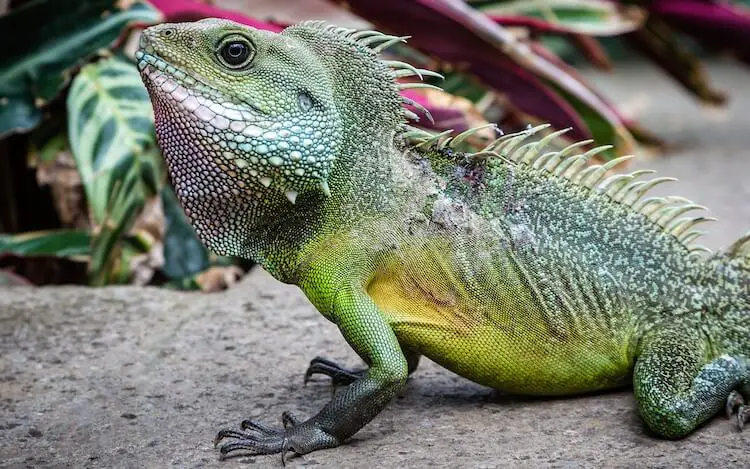
Chinese Water Dragons typically live 10 to 15 years in captivity. However, with excellent husbandry and care, they can live up to 20 years.
In captivity, they are prone to a multitude of health issues including several types of infections.
Mouth rot is one of the most common health abnormalities experienced by this species in captivity. It involves an infection of both the mouth and gums and is typically associated with inflammation and pus.
Veterinarians can prescribe a course of antibiotics for 14 days to treat this illness. With antibiotics, the prognosis for mouth rot is good. But, medications and vet bills to treat this condition can cost approximately $200 USD.
Bathing is not necessary if a fresh pan of water is provided to them daily.
If you choose to bath, pouring water gently over their body and tail is appropriate. Do not pour water directly on their head as they can aspirate on the water and develop pneumonia.
| Signs They Are Healthy | Sickness Symptoms |
|---|---|
| Clear skin and free of blemishes | Sunken eyes |
| A healthy appetite | Unwillingness to eat |
| Active throughout the day, jumping and swimming | Lethargy |
| Well-formed and normal colored feces (black/white) | An irritated and inflamed snout |
Typical Behavior
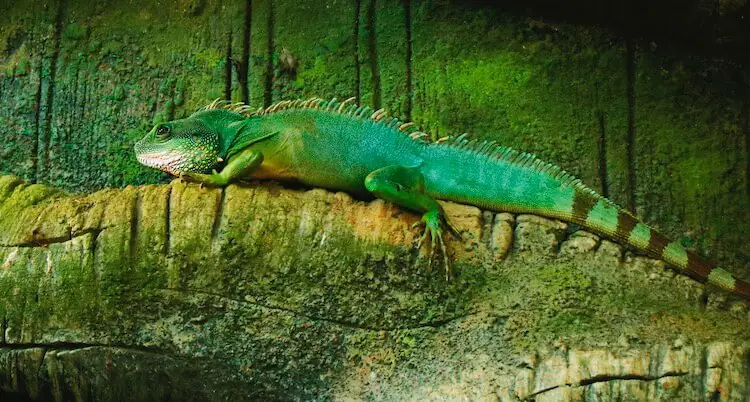
Expected behaviors of a Chinese Water Dragon in captivity include:
- Basking
- Jumping across branches
- Swimming
- Running
- Digging
- Hunting
They mainly communicate with each other through physical movements such as push-ups and head bobbing.
Chinese Water Dragons are sociable. It is ideal to keep them in pairs or small groups when kept in captivity. When housed in groups, they form a hierarchy with one lizard showing dominance over the others. Typically, the largest lizard will be the most dominant.
They love to climb and swim and are extremely active in the wild. Having opportunities to perform these activities in captivity is essential.
Not known to be an aggressive lizard, generally, they will choose to hide or flee instead of attacking as long as they have a path to escape from perceived threats.
Signs of aggression can include: puffing of their throat, tail whipping, and biting.
Chinese Water Dragons will undergo brumation in winter months, so their activity level and food intake will decrease with colder temperatures as a normal annual process.
Handling
If handled daily, most owners report their Water Dragons as being docile and friendly. They tolerate handling as long as they do not feel restrained or pinned down.
When compared to Iguanas, they have much better temperaments.
It is important to start handling from a young age.
Handling should be slowly introduced in to their routine, and treats can be used to encourage handling.
You should start off handling for 5 to 10 minutes each day and slowly add more time (as they become more comfortable).
Two hands should be used to support adults. They should never be restrained or held down as this causes them a lot of stress.
Like most lizards, Chinese Water Dragons should never be held by their tails because they can fall off as a defense mechanism.
Chinese Water Dragon Hatchlings
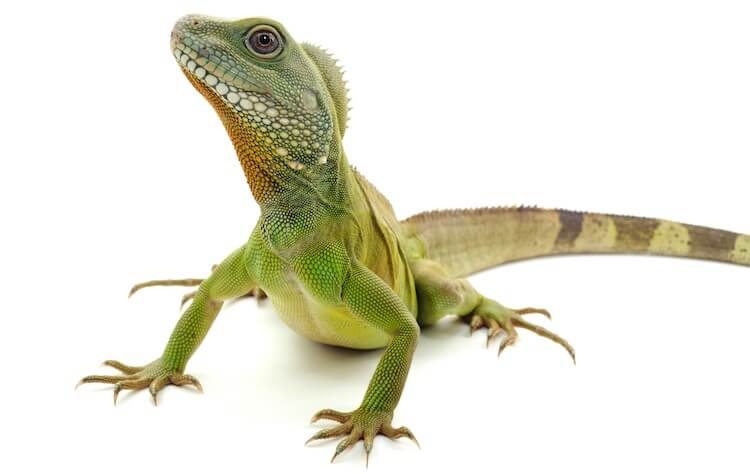
Males attract females through a variety of behaviors including push-ups, head bobbing, throat puffing, and hand waving.
Leading up to the breeding season, the tank temperature should be reduced by 5 degrees to encourage mating behaviors. Additionally, light can be reduced for one to two hours each day. These conditions should be kept for one to two months (typical conditions for brumation), and then normal temperatures and hours of daylight should be reintroduced to trigger mating.
Mating season is in the spring and lasts 2 to 3 months. It takes approximately 65 days for their eggs to hatch, and they generally have around 10 eggs.
It takes around 20 minutes for the mating process to occur.
After they copulation, males and females should be separated to prevent aggression, stress, and injury. Some owners choose to allow a second mating a few days later to ensure the female is bred.
Females will bury their eggs, so having at least 10 inches of substrate is necessary. The eggs should be moved to an incubator one day after being laid.
How Much Does A Chinese Water Dragon Cost?
Chinese Water Dragons can be difficult to find in pet stores due to their large size. They generally cost around $50 USD. It may be best to purchase from a reputable breeder because of their tendency to develop medical conditions if not housed properly, it also helps their species’ conservation status.
Summary
| Vital Facts | |
|---|---|
| Common Name | Chinese Water Dragon |
| Scientific Name | Physignathus cocincinus |
| Price | ~$50 |
| Size | 36 inches Snout to vent length of 2 inches at birth |
| Lifespan | 12 to 20 years |
| Diet | Omnivores |
| Tank Size | 75 gallon wooden vivarium |
| Humidity & Temperature | Daytime temperature: 85 degrees Night-time temperature: 75 degrees Humidity: 70% |
| Popular Alternatives | Green Iguana, Asian Water Monitor |
Chinese Water Dragons are popular Lizards due to their distinct color, relatively large size, and ability to swim. They are quite active enjoying swimming, jumping, and digging.
However, because they are prone to many health conditions (and have complicated housing and dietary needs), Water Dragons do not typically make great pets for first time owners.
For those with previous reptile husbandry experience, who can provide consistent husbandry and monitor their enclosure closely, this species can be an excellent addition.
They require daily handling and time outside of their enclosures to prevent aggression.
If you are looking for an intelligent and personable lizard, with many unique activities and behaviors, this species is a great choice. Let us know what you think below!

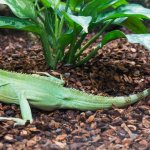

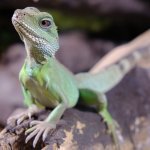
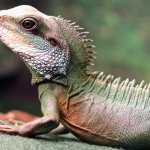

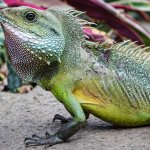
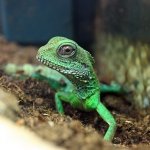
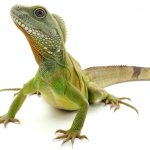
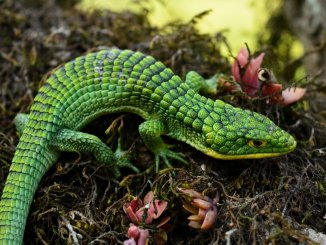
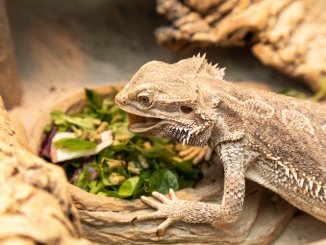
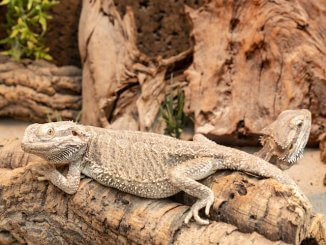

Our longtime Chinese water dragon died and we would like to get a new one. Where can we responsibly buy one? The last was bought at a pet store that I really don’t want to go to.